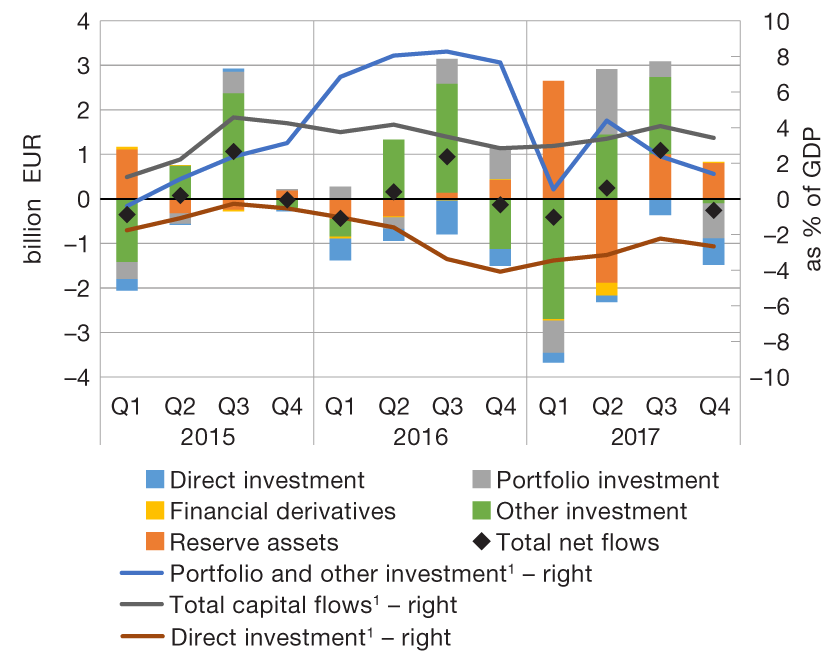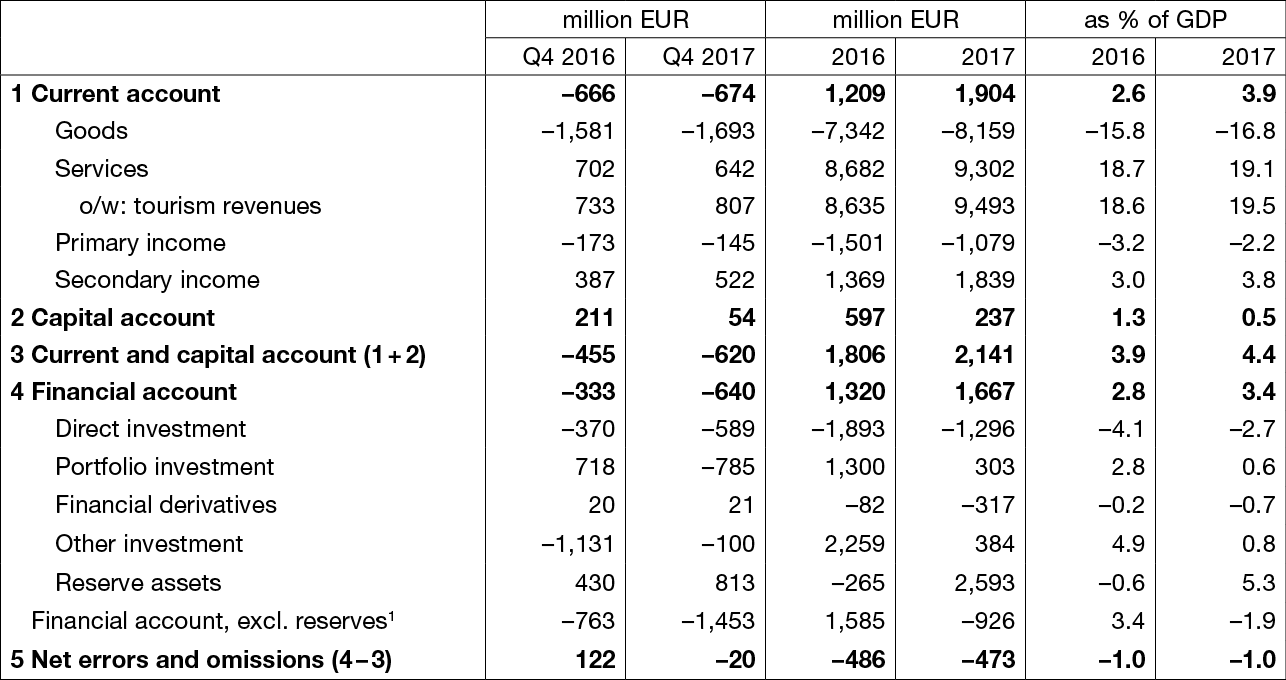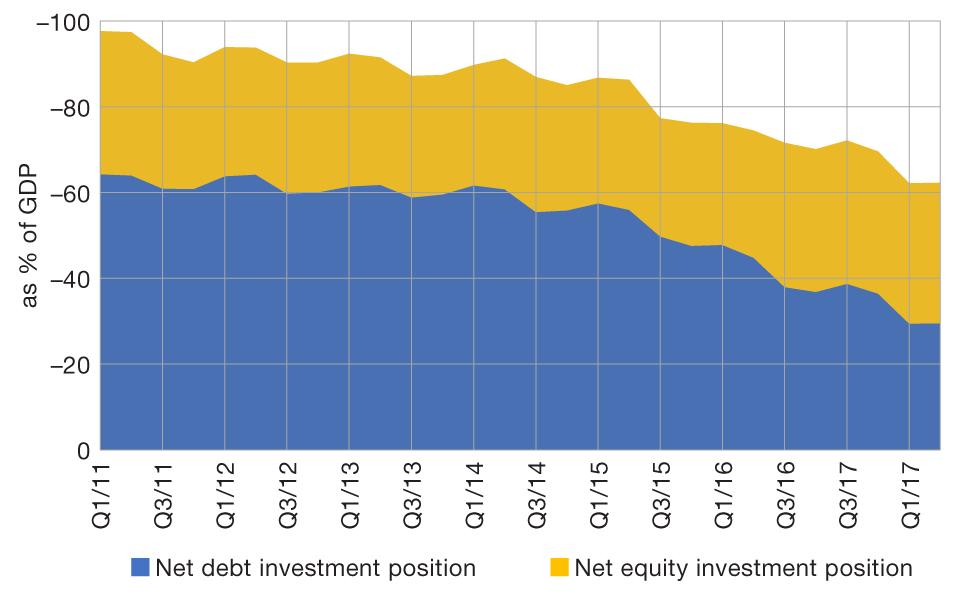From August 2023 the comments on statistics, a short description of selected, recently issued statistical data in the area of monetary statistics and the non-residents sector statistics, are no longer published. They are replaced by Statistical releases.
Comments on the balance of payments and the international investment position in 4Q 2017
The current and capital account of the balance of payments ran a deficit of EUR 0.6bn in the last quarter of 2017, having widened EUR 0.2bn from the same period of the previous year. Such trends were primarily a result of a deterioration in the balance of foreign trade in goods and services. At the same time, the overall secondary income and capital account balance deteriorated only slightly, while the deficit in the primary income account narrowed somewhat.
The widening of the foreign trade deficit continued into the fourth quarter of 2017, having increased by EUR 0.1bn from the same period the year before, with imports and exports growing at the same pace (by 6.9%). On the other hand, the drop in the net exports of services was due to the significantly stronger rise in the imports than in the exports of services (17.9% versus 7.0%). This was primarily caused by a marked increase in the residents' tourist spending abroad (up by almost a half), while tourism revenues rose by 10.1%. The trade balance deteriorated slightly in transportation services and stagnated in other services.
The slight narrowing of the deficit in the primary income account seen in the fourth quarter of 2017 was mainly a result of lower interest expenditures on external debt, while net revenues from compensation of employees also increased. On the other hand, the increase in net expenditures on direct equity investment (dividends and reinvested earnings) had a negative effect on the primary income account balance as the better business performance of foreign-owned companies (primarily in construction and real estate activities) and banks surpassed the improvement in the business performance of foreign enterprises owned by residents.
The overall secondary income and capital account balance deteriorated somewhat in the fourth quarter of 2017, with a rise seen in net revenues from secondary income and a decline recorded in capital transactions. Such developments primarily reflect the dynamics in the volume of transactions with the EU budget. Although total revenues arising from transactions with the EU budget saw a moderate increase, end beneficiaries were distributed significantly more funds for current expenditures, while the amount of distributed capital funds was substantially reduced from the same period in 2016.
Figure 1 Balance of payments
| a) Current and capital account | b) Financial account |
 |
 |
1 The sum of the last four quarters
Note: In the figure above showing the financial account, the positive value denotes net capital outflow abroad and the negative value denotes net capital inflow.
Source: CNB.
The financial account of the balance of payments saw a net capital inflow of EUR 0.6bn in the fourth quarter of 2017, which is almost twice as much as in the same period the year before. Broken down by account, strong net capital inflow was recorded in the portfolio investment and direct investment accounts, and, to a lesser extent, in the other investment account. Gross international reserves increased in the same period.
Net inflow from foreign direct investment stood at EUR 0.6bn in the fourth quarter of 2017, up by EUR 0.2bn from the same period in the preceding year. Reinvested earnings of foreign-owned enterprises and banks grew, as did debt liabilities of enterprises towards affiliated creditors abroad, whereas new equity investments of non-residents in Croatia were relatively modest, amounting to only EUR 0.1bn, only slightly below the level recorded in the fourth quarter of 2016.
The strong net capital inflow in the portfolio investment account (of EUR 0.8bn) is primarily attributable to the increase in the negative net foreign position of the government sector which issued an international bond to refinance the liabilities of road sector enterprises to domestic credit institutions and, to a smaller extent, to foreign creditors. The moderate net capital inflow in the other investment account (of EUR 0.1bn) resulted from a more pronounced decrease in foreign assets than in foreign liabilities. Gross international reserves went up substantially (by EUR 0.8bn) as a consequence of foreign exchange purchase from banks.
Table 1 Balance of payments

1 Excluding the change in gross international reserves and foreign liabilities of the CNB (investment of a part of reserves in reverse repo agreements results in a simultaneous, same-amount increase in assets and liabilities of the CNB).
Note: The positive value of financial transactions denotes net capital outflow abroad and the negative value denotes net capital inflow.
Source: CNB.
Net foreign capital inflow also resulted in a mild deterioration of the net international investment position of the Republic of Croatia in the fourth quarter of 2017, causing it to decrease by EUR 0.3bn. Overall, the net international investment position stood at EUR –30.3bn, or –62.3% of GDP at end-2017 (Figure 2).
Despite the deterioration of the current and capital account balance recorded in the last quarter, the whole of 2017 saw an increase in the current and capital account surplus to 4.4% of GDP, which is 0.5 percentage points higher than in 2016. The continued growth in the net exports of services and the drop in the primary income account deficit (due to the fall in the profits of banks based on provisions for loans related to the Agrokor Group) contributed to the increase in the surplus. Total net capital outflow on the financial account increased accordingly, primarily in terms of a rise in international reserves. Such developments in the financial account resulted in an improvement of the net international investment position, whose relative indicator decreased by seven percentage points from the end of 2016 at end-2017 (Figure 2).
Figure 2 International investment position (net) by sectors

Note: The international investment position (net) equals the difference between domestic sectors' foreign assets and liabilities. Net debt investments include financial derivatives.
Source: CNB.
Data revision
Data on the balance of payments and the international investment position are revised in accordance with the commonly used practice, based on data obtained after the last quarterly dissemination.
Detailed balance of payments data
Detailed data on the international investment position
